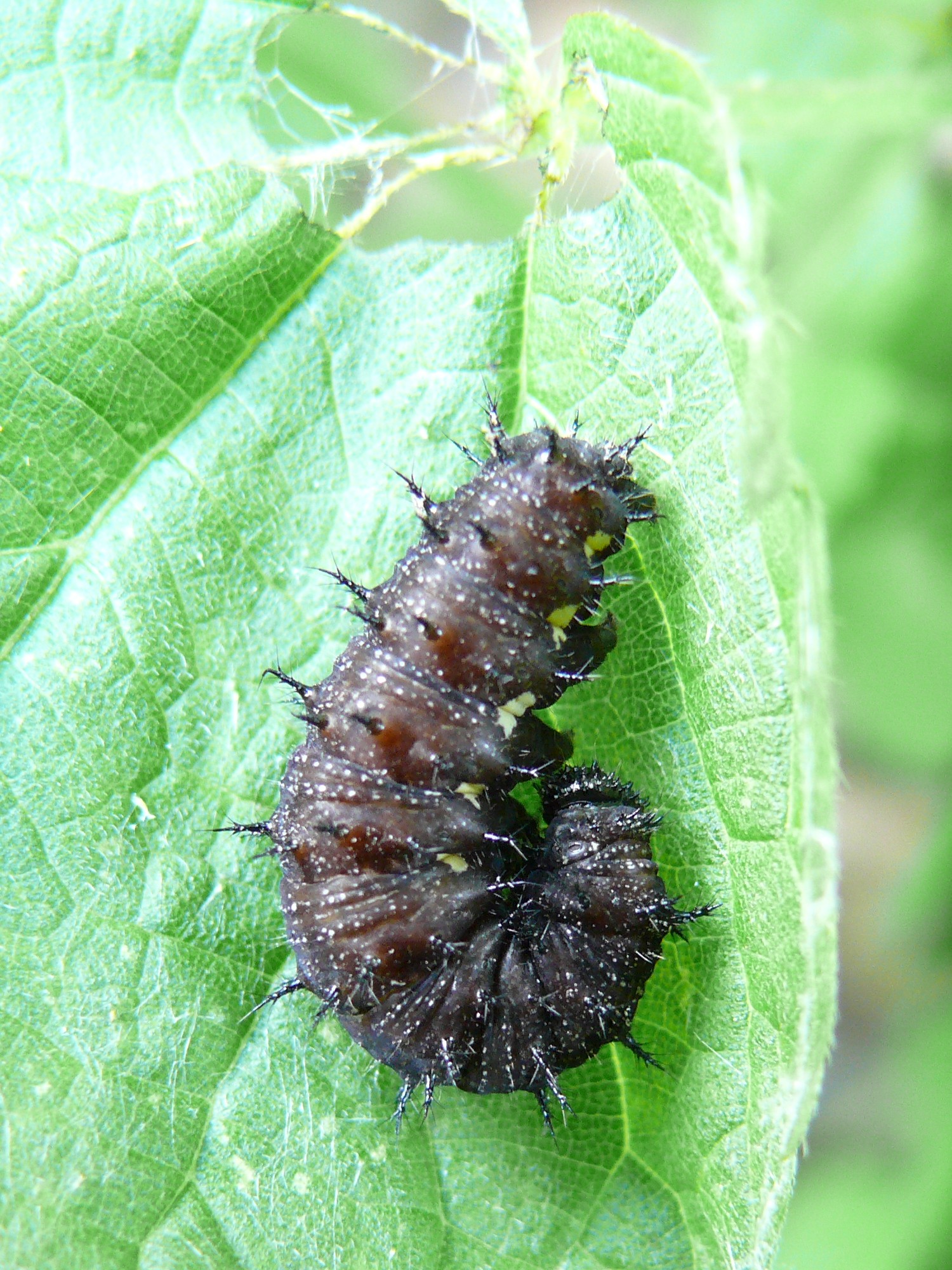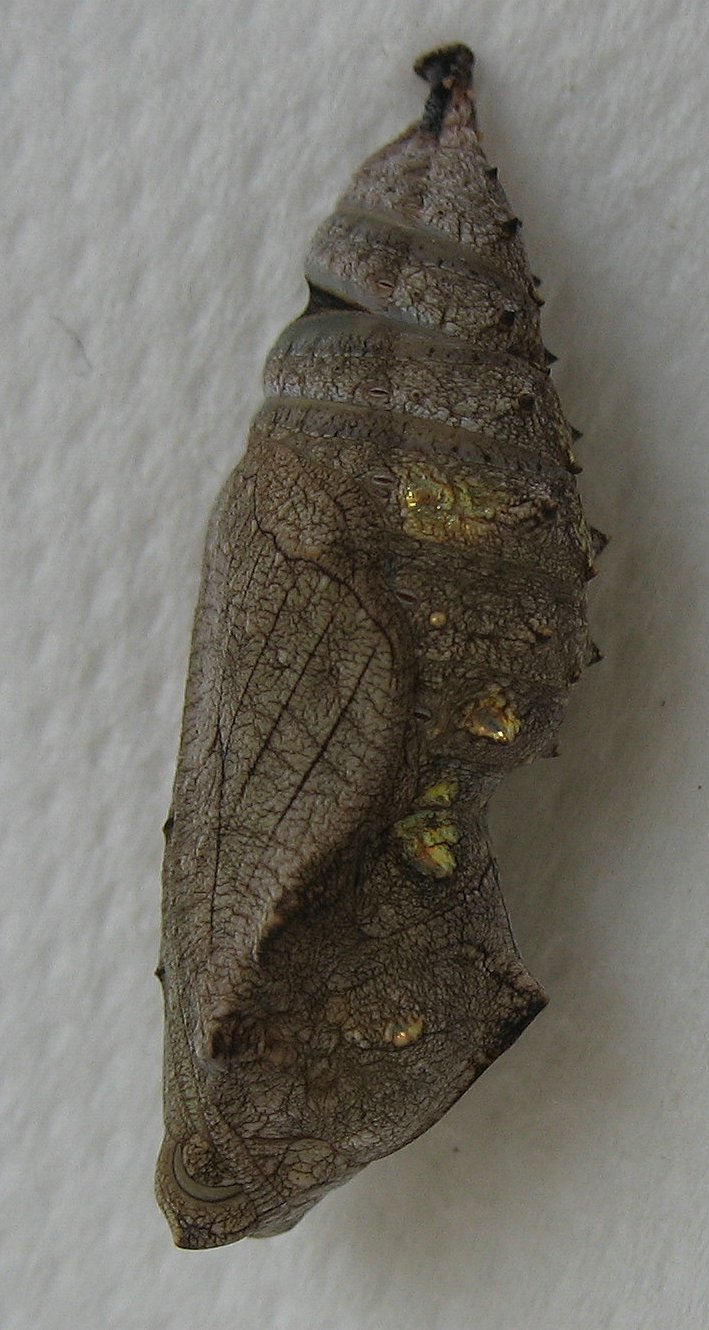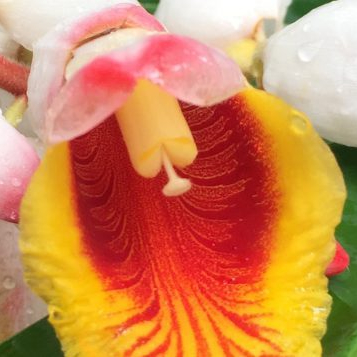red admiral butterfly
Almost everyone has seen the pretty red admiral at one time or another: Vanessa atalanta is a medium-sized butterfly with black wings, orange bands, and white spots.
Red admiral caterpillars feed largely on plants in the nettle family, which most people don’t love to have in their garden, so if you don’t love plants that sting, red admiral caterpillars are your friends. Conversely, in order to have red admirals, we need to have some nettles. Luckily, false nettles and Florida pellitory are host plants that are stingless. Pellitory is considered a weed and false nettle isn’t especially ornamental (around our house, it pops up annoyingly in all our flowerpots), so they are good plants for a naturalized butterfy garden but not necessarily anything you want to look formal.
It’s an unusually people-friendly butterfly, often landing on and using humans as perches.
Appearance
Admirals have a wingspan of about 2 inches, ranging between 1.75 inches and 2.5 inches. The red admiral is identified by its striking black, orange, and white wing pattern and has summer and winter morphs. Summer red admirals are larger and more pigmented than winter morphs.
Range
The red admiral is widely distributed across temperate regions of North Africa, the Americas, Europe, Asia, and the Caribbean. It lives in warmer areas, but migrates north in spring and sometimes again in autumn. Most of North America must be recolonized each spring by southern migrants, but the species over winters in south Texas. Adults are found throughout Florida.
Feeding
The adult butterfly drinks from flowering plants like Buddleia, but they prefer fermenting tree sap, fruit, and (delightfully) fresh dung to flower nectar. Certain plants of the families Compositae (aster/sunflower) and Cannabaceae (cannabis) may also be used as hosts. In Florida, the most common hosts are: false nettle (Boehmeria cylindrica) , Florida pellitory (Parietaria floridana), heartleaf nettle ( (Urtica chamaedryoides), and the naturalized exotic stinging nettle (Urtica dioica) and burning or dwarf nettle (Urtica urens). Canadian wood nettle (Laportea canadensis) is commonly utilized farther north but this species is rare in Florida and restricted to the Panhandle. They also drink from moist soil. In our garden, we often see them on aloe flowers.
Breeding
Male red admirals are territorial and perch during the afternoon until sunset. Larger territories are optimal and subject to intrusion by other males more frequently than smaller territories. Territories tend to be oval, 8–24 feet long and 13–42 feet wide. Males patrol their territory by flying around the perimeter between 7 and 30 times per hour. On average, territory holders interact with intruders 10 to 15 times per hour.
When another male encroaches on a red admiral’s territory, the resident chases away the intruder, often in a vertical, helical path to disorient or tire out the intruder while minimizing the horizontal distance it travels from its perch. The red admiral immediately returns to its territory after chasing off encroaching males. Time spent patrolling increases as number of the intruder interactions increases.
Patrolling behavior is correlated with warmer air temperatures, so males begin patrolling early and continue later on warmer days. Overcast skies usually led to patrolling later in the day. It is not clear whether this later start time is due to lower air temperature or a direct effect of decreased solar radiation. Another theory is that males believe it is earlier in the morning on cloudy days because of the reduced solar radiation.
Male red admirals court females for several hours before they begin mating. Because of female choice, only males with territory have the opportunity to mate. Females select males with traits that will increase the mating success of their offspring. Only males of exceptional flying ability are able to chase off intruding males and successfully court females.
Mating usually occurs in late fall or early winter following collective migration to southern regions with a warmer climate. The red admiral’s main host plant, stinging nettle, is most abundant during this migration. Larval development proceeds through winter and adults are first sighted in early spring. The new generation of adults migrates north before mating, because food is usually diminished by late spring. During migration, the red admiral flies at high altitudes where high-speed winds carry the butterfly, requiring less energy.
Red Admiral Fun Facts: Vision
Red admirals have color vision in the 440–590 nm range of the visible spectrum which includes indigo, blue, green, and yellow. They have compound eyes with a transparent, crystalline structure called a rhabdom which is similar in function to a human retina. These butterflies do not have the specific lateral filtering pigments coating their rhabdom found in some other nymphalid butterflies that likely evolved later. A consequence of this lack of pigment is that the red admiral cannot differentiate between colors in the 590–640 nm range, which includes orange and red.
red admiral butterfly
 By Thomas Bresson – Vulcain, CC BY 2.0, Link
By Thomas Bresson – Vulcain, CC BY 2.0, Link
On the dorsal side, its dark wings possess orange bands on the middle of the forewings and the outer edge of the hindwings. The distal ends of the forewings contain white spots.
 By Charles J Sharp – Own work, CC BY-SA 4.0, Link
By Charles J Sharp – Own work, CC BY-SA 4.0, Link
The ventral side of the wings are brown with patches of red, white, and black. The hindwings have a brown marbled pattern.
red admiral butterfly eggs
 By Emmanuel Boutet – Own work, CC BY-SA 3.0, Link
By Emmanuel Boutet – Own work, CC BY-SA 3.0, Link
Typically found in moist woodlands, the red admiral caterpillar’s primary host plant is the stinging nettle (Urtica dioica) but can also be found on the false nettle (Boehmeria cylindrica). In North America, the red admiral generally has two broods from March through October in the north but have up to four broods in Florida.
Eggs are laid singly on the leaves of the host plants. The larvae make leaf nests by silking together several of the smaller leaves of Parietaria (nettle) species or by silking together the sides of the larger leaves of nettles to form a tube. Each caterpillar makes a number of shelters during its lifetime. Older larvae chew partially through the petioles of the folded leaf nests, causing them to droop.
Early instar red admiral caterpillar
 By James Lindsey at Ecology of Commanster, CC BY-SA 3.0, Link
By James Lindsey at Ecology of Commanster, CC BY-SA 3.0, Link
Red admiral larvae are approximately 1 inch long. They are usually black with white spots and spines but can be other colors. These spines persist into the pupal phase.
Late instar red admiral caterpillar
 By Harald Süpfle – Own work, CC BY-SA 2.5, Link
By Harald Süpfle – Own work, CC BY-SA 2.5, Link
red admiral chrysalis
 By Emmanuel Boutet – Own work, CC BY-SA 3.0, Link
By Emmanuel Boutet – Own work, CC BY-SA 3.0, Link
The pupae are bright scarlet at high temperatures and black with a smaller scarlet area at low temperatures. This differential coloration at various temperatures may explain why the summer form of the red admiral is brighter and more heavily pigmented than the winter form. There is some disagreement on whether pupae overwinter.

One Comment Add yours